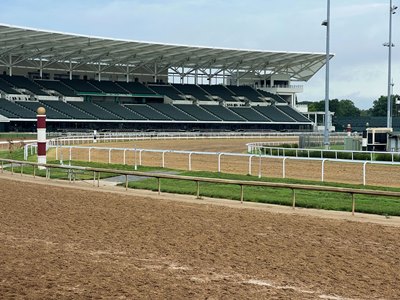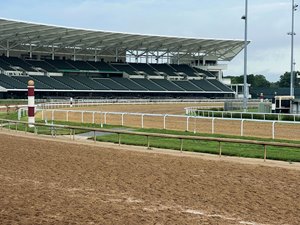Churchill Continues Efforts to Remedy Turf Course


The turf course at Churchill Downs, brown and unsightly from postspring meet maintenance meant to strengthen its root structure and growth, is planned for use during the track's September meet, according to Darren Rogers, the track's senior director of communications and media services.
Following meets at Ellis Park and Kentucky Downs, racing resumes at Churchill in less than two months, with its September meet taking place Sept. 12-29. Kentucky racing then shifts to Keeneland before returning to Churchill for a fall meet from Oct. 27-Dec. 1.
The track's $10 million turf course, installed with sod in the fall of 2021, initially received positive reviews from riders and horsemen when introduced in the spring of 2022 before it began experiencing problems after regular usage. The track ran only 20 turf races apiece during its September and fall meets of last year, but after winter and spring maintenance was performed, Churchill was able to race over it through its spring meet this year, though it showed wear and tear. Seventy-four turf races were run on grass during this past meet April 27-June 30.
"We're continuing our tweaks of the turf course following the spring meet," Rogers said. "We're committed to get it to perform at its maximum and it's a work in progress. It was much improved from last year's fall meet, but we're still dissatisfied with the status of the course.
"We've had numerous discussions with our team, consultants, engineers, and the horsemen, and we believe the remedies that we introduced this winter and spring have us headed in the right direction and, as planned, we've introduced additional solutions following the spring meet."
According to Rogers, those remedies include scalping the turf course, which means cutting the grass extremely low so the stems and soil are exposed to sunlight to stimulate growth. Scalping can brown grass.
Over the past two weeks, Churchill maintenance also verticut the turf to remove organic buildup, used a KORO Recycling Dresser to aerate the course and a DryJect process to inject sand into the turf to allow roots to penetrate deeper, and sprigged about a thousand bushels of Iron Cutter bermuda grass around the course, followed by fertilization.
To date, Churchill has opted not to start from scratch by seeding a new turf course. Having a ready, mature grass course is vital to the track when it runs Kentucky Derby (G1) week each spring.
"Timing is obviously key," Rogers said.
When asked if the course could recover sufficiently and regrow following these treatments to be ready when racing resumes there Sept. 12, Rogers replied, "That's the plan."
"Our plan all along is to be more vigilant in the management of the organic material," he added. "That's what we said last year, and that's what we're continuing to do. We've had the challenges along the way, but the team is committed to have this course perform at its maximum, and we're continuing to do whatever it takes."
